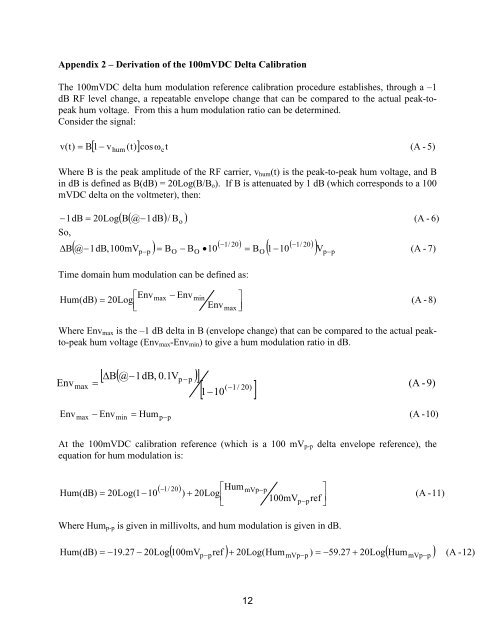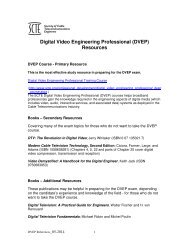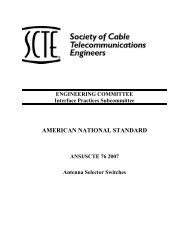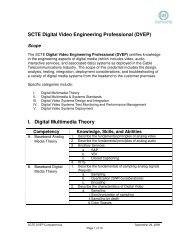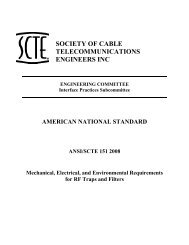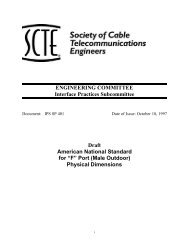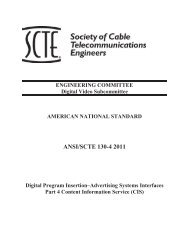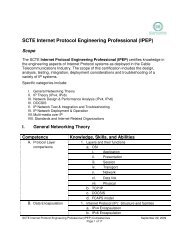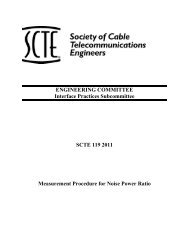Test Procedure for Hum Modulation - SCTE
Test Procedure for Hum Modulation - SCTE
Test Procedure for Hum Modulation - SCTE
You also want an ePaper? Increase the reach of your titles
YUMPU automatically turns print PDFs into web optimized ePapers that Google loves.
Appendix 2 – Derivation of the 100mVDC Delta Calibration<br />
The 100mVDC delta hum modulation reference calibration procedure establishes, through a –1<br />
dB RF level change, a repeatable envelope change that can be compared to the actual peak-topeak<br />
hum voltage. From this a hum modulation ratio can be determined.<br />
Consider the signal:<br />
v(t)<br />
= B 1<br />
[ − v (t)] cosω<br />
t<br />
(A - 5)<br />
hum<br />
Where B is the peak amplitude of the RF carrier, v hum (t) is the peak-to-peak hum voltage, and B<br />
in dB is defined as B(dB) = 20Log(B/B o ). If B is attenuated by 1 dB (which corresponds to a 100<br />
mVDC delta on the voltmeter), then:<br />
− dB = 20Log B @ −1dB<br />
So,<br />
∆B<br />
Time domain hum modulation can be defined as:<br />
c<br />
( ( )/<br />
B ) (A - 6)<br />
1 o<br />
( − ) ( )<br />
(@<br />
1dB,100mV ) B B 10<br />
1/ 20<br />
− 20<br />
−<br />
= − • = B 1−10<br />
1/<br />
p−p<br />
O<br />
O<br />
O<br />
( ) V<br />
(A - 7)<br />
p−p<br />
Env<br />
<strong>Hum</strong>(dB) = 20Log<br />
⎡<br />
⎢⎣<br />
max<br />
− Env<br />
min<br />
Env<br />
max<br />
⎤<br />
⎥⎦<br />
(A - 8)<br />
Where Env max is the –1 dB delta in B (envelope change) that can be compared to the actual peakto-peak<br />
hum voltage (Env max -Env min ) to give a hum modulation ratio in dB.<br />
[ ∆B (@<br />
−1dB,<br />
0.1Vp<br />
−p<br />
)] [ ]<br />
(A - 9)<br />
Env max =<br />
( −1/<br />
20<br />
1−10<br />
)<br />
Env<br />
max<br />
− Env<br />
min<br />
= <strong>Hum</strong><br />
p−p<br />
(A -10)<br />
At the 100mVDC calibration reference (which is a 100 mV p-p delta envelope reference), the<br />
equation <strong>for</strong> hum modulation is:<br />
( −1/<br />
20)<br />
⎡<strong>Hum</strong><br />
<strong>Hum</strong>(dB) = 20Log(1 −10<br />
) + 20Log⎢<br />
⎣<br />
mVp−p<br />
100mV<br />
p−p<br />
⎤<br />
ref ⎥<br />
⎦<br />
(A -11)<br />
Where <strong>Hum</strong> p-p is given in millivolts, and hum modulation is given in dB.<br />
<strong>Hum</strong>(dB)<br />
= −19.27<br />
− 20Log 100mV<br />
( ref ) + 20Log(<strong>Hum</strong> ) = −59.27<br />
20Log( <strong>Hum</strong> ) (A -12)<br />
p− p<br />
mVp−p<br />
+<br />
mVp−p<br />
12


